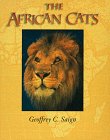.
Check out these spectacular National Geographic Videos at:![]()
National Geographic stands for quality! Order them now and click
on the video you like.
More videos and information at our
|
|
|
Lions and Hyenas 
Read about this video |

Read about this video |
 Check
it Out and order now! Check
it Out and order now!
•The African Cats by Geoffrey C. Saign Reading level: Ages 9-12 |
In the same First Books: Animals series as Saign's The
Great Apes (1998), this combines dramatic wildlife colour photographs with
a lively, informative text. After a general introduction that
includes facts about evolution (with a double-page family tree), Saign looks in turn at each of 10 African cats, from the lion, leopard, and cheetah to the tiny sand cat. In each case, he discusses basic issues, such as where they live and how they hunt, mate, and care for their young. A final section focuses on conservation and includes a chart on the estimated population of each cat. With a glossary and a resource guide for books, CD-ROMS, and organizations, this attractively designed book will attract middle-graders for classroom research and for personal interest. |